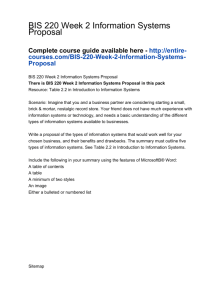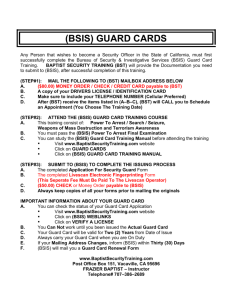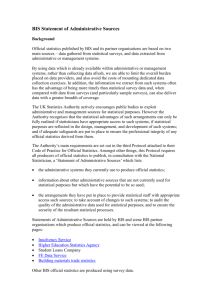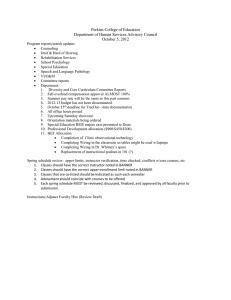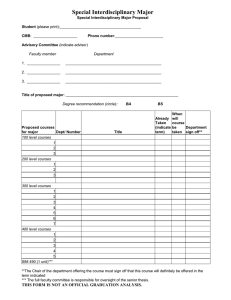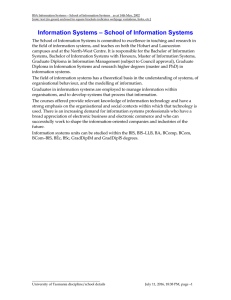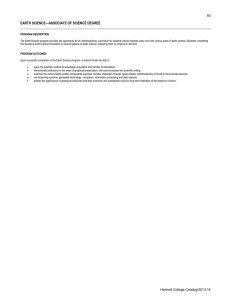DELTA STATE UNIVERSITY
advertisement
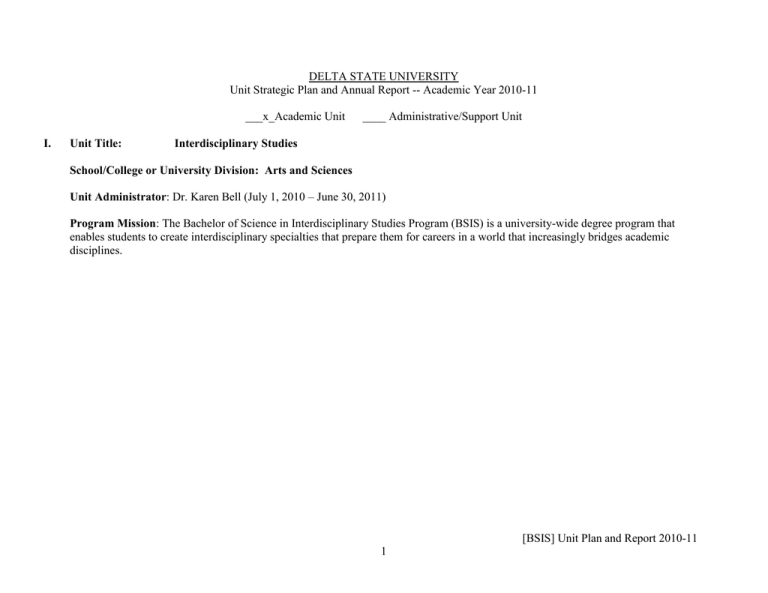
DELTA STATE UNIVERSITY Unit Strategic Plan and Annual Report -- Academic Year 2010-11 ___x_Academic Unit I. Unit Title: ____ Administrative/Support Unit Interdisciplinary Studies School/College or University Division: Arts and Sciences Unit Administrator: Dr. Karen Bell (July 1, 2010 – June 30, 2011) Program Mission: The Bachelor of Science in Interdisciplinary Studies Program (BSIS) is a university-wide degree program that enables students to create interdisciplinary specialties that prepare them for careers in a world that increasingly bridges academic disciplines. [BSIS] Unit Plan and Report 2010-11 1 II. Student Learning Outcomes Assessment Plan / User Outcomes Assessment Plan Table I: Learner Outcomes identified for the major and for student services and support. TABLE I – Student Learning Outcomes A. Learner Outcome What should a graduate in the _____________ major know, value, or be able to do at graduation and beyond? Demonstrate understanding of interdisciplinary ideas, methods, and practice GE 3 B. Data Collection & Analysis 1. What assessment tools and/or methods will you use to determine achievement of the learning outcome? 2. Describe how the data from these tools and/or methods will be/have been collected. 3.Explain the procedure to analyze the data. 1. Tools: a) Chapter review questions and quizzes exploring definitions of and application of interdisciplinary studies; an Intellectual Autobiography and a Critique of two articles and a short video (BIS 300) b) Chapter review questions and quizzes exploring quantitative and qualitative interdisciplinary research; analytical research essays (BIS 310) c) Capstone Proposal (BIS 400) d) Capstone Project (BIS C. Results of Evaluation D. Use of Evaluation Results What were the findings of the analysis? 1.List any specific recommendations. 2. Describe changes in curriculum, courses, or procedures that are proposed or were made/ are being made as a result of the program learning outcome assessment process. Findings: The percentage of In Progress decreased from 4 % in 09-10 to 1 % in 10-11 The unsuccessful rate remained level. The area of unsuccessful trend is apparent in the introductory core courses but has improved due to the use of a course template in the online component and the use of rubrics for every assignment. Completion of coursework at established competency level of 70% or more. 1. Recommendations: Continue the use of rubrics but fine tune them Improve the success rates of BIS 300 and BIS 310 by giving students information on helpful websites, tutorials, and through re-evaluation of the course syllabi Increase student use of technology as interdisciplinary tool (SP Goal 1, QEP goal 2,3) Increase students’ awareness of community as interdisciplinary concept (SP Goals 1,5, [BSIS] Unit Plan and Report 2010-11 2 410) 2. Data Collection: a) Common rubrics used for all review questions, intellectual autobiography, critique (BIS 300) Students must attain at least 70% of all possible points for the course to demonstrate competency. b) Common rubrics used for all review questions and analytical research essays (BIS 310) Students must attain at least 70% of all possible points for the course to demonstrate competency. c) Common rubrics used to evaluate each proposal, drafts and final versions (BIS 400) Students must attain at least 70% of all possible points for the course to demonstrate competency. d) Common rubrics used to evaluate portfolio and presentation (BIS QEP Goal 4) 2. Changes Made: Continued the evaluation process during the initial stage of the portfolio process – two essays collected to measure critical thinking and understanding of interdisciplinary studies and concepts. BIS 310 research essays are initial evidence of interdisciplinary exploration with applicable research methods Using a template, designed by Susan Hines, for the Blackboard/online components which is consistent and pedagogically sound Changes Being Considered: Increase advising contacts with faculty in a variety of disciplines [BSIS] Unit Plan and Report 2010-11 3 A. Learner Outcome What should a graduate in the ___________ major know, value, or be able to do at graduation and beyond? Apply quantitative and qualitative research methods, communicate pragmatic and thoughtful responses to ethical questions and contemporary issues 410) Students must attain at least 70% of all possible points for the course to demonstrate competency. 3. Analysis: Portfolios used to collect and evaluate students’ learning and progress towards degree by BSIS director B. Data Collection & Analysis 1. What assessment tools and/or methods will you use to determine achievement of the learning outcome? 2. Describe how the data from these tools and/or methods will be/have been collected. 3.Explain the procedure to analyze the data. 1. Tools: a) Chapter review questions and quizzes exploring definitions of and application of interdisciplinary studies; an Intellectual Autobiography and a Critique of two articles and a short video (BIS 300) b) Chapter review questions and quizzes exploring quantitative and qualitative interdisciplinary research; analytical research essays (BIS 310) c) Capstone Proposal (BIS 400) d) Capstone Project (BIS 410) C. Results of Evaluation D. Use of Evaluation Results What were the findings of the analysis? 1.List any specific recommendations. 2. Describe changes in curriculum, courses, or procedures that are proposed or were made/ are being made as a result of the program learning outcome assessment process. Findings: The percentage of In Progress decreased from 4 % in 09-10 to 1 % in 10-11 The unsuccessful rate remained level. The area of unsuccessful trend is apparent in the introductory core courses but has improved due to the use of a course template in the online component and the use of rubrics for every assignment. Completion of coursework at established competency level of 70% or more. 1. Recommendations: Continue the use of rubrics but fine tune them Improve the success rates of BIS 300 and BIS 310 by giving students information on helpful websites, tutorials, and through re-evaluation of the course syllabi Increase student use of technology as interdisciplinary tool (SP Goal 1, QEP goal 2,3) Increase students’ awareness [BSIS] Unit Plan and Report 2010-11 4 of community as interdisciplinary concept (SP Goals 1,5, QEP Goal 4) 2. Changes Made: Continued the evaluation process during the initial stage of the portfolio process – two essays collected to measure critical thinking and understanding of interdisciplinary studies and concepts. BIS 310 research essays are initial evidence of interdisciplinary exploration with applicable research methods Using a template, designed by Susan Hines, for the Blackboard/online components which is consistent and pedagogically sound 2. Data Collection: a) Common rubrics used for all review questions, intellectual autobiography, critique (BIS 300) Students must attain at least 70% of all possible points for the course to demonstrate competency. b) Common rubrics used for all review questions and analytical research essays (BIS 310) Students must attain at least 70% of all possible points for the course to demonstrate competency. c) Common rubrics used to evaluate each proposal, drafts and final versions (BIS 400) Students must attain at least 70% of all possible points for the course to demonstrate competency. d) Common rubrics used to evaluate portfolio and presentation (BIS 410) Students must attain at least 70% of all possible points for the course to demonstrate competency. Changes Being Considered: Increase advising contacts with faculty in a variety of [BSIS] Unit Plan and Report 2010-11 5 disciplines A. Learner Outcome What should a graduate in the ___________ major know, value, or be able to do at graduation and beyond? Produce scholarship/project that demonstrates interdisciplinary acumen and ability 3. Analysis: Portfolios used to collect and evaluate students’ learning and progress towards degree by BSIS director B. Data Collection & Analysis 1. What assessment tools and/or methods will you use to determine achievement of the learning outcome? 2. Describe how the data from these tools and/or methods will be/have been collected. 3.Explain the procedure to analyze the data. 1. Tools: a) Chapter review questions and quizzes exploring definitions of and application of interdisciplinary studies; an Intellectual Autobiography and a Critique of two articles and a short video (BIS 300) b) Chapter review questions and quizzes exploring quantitative and qualitative interdisciplinary research; analytical research essays (BIS 310) c) Capstone Proposal (BIS 400) d) Capstone Project (BIS 410) C. Results of Evaluation D. Use of Evaluation Results What were the findings of the analysis? 1.List any specific recommendations. 2. Describe changes in curriculum, courses, or procedures that are proposed or were made/ are being made as a result of the program learning outcome assessment process. Findings: The percentage of In Progress decreased from 4 % in 09-10 to 1 % in 10-11 The unsuccessful rate remained level. The area of unsuccessful trend is apparent in the introductory core courses but has improved due to the use of a course template in the online component and the use of rubrics for every assignment. Completion of coursework at established competency level of 70% or more. 1. Recommendations: Continue the use of rubrics but fine tune them Improve the success rates of BIS 300 and BIS 310 by giving students information on helpful websites, tutorials, and through re-evaluation of the course syllabi Increase student use of technology as interdisciplinary tool (SP Goal 1, QEP goal 2,3) Increase students’ awareness of community as interdisciplinary concept (SP Goals 1,5, [BSIS] Unit Plan and Report 2010-11 6 QEP Goal 4) 2. Changes Made: Continued the evaluation process during the initial stage of the portfolio process – two essays collected to measure critical thinking and understanding of interdisciplinary studies and concepts. BIS 310 research essays are initial evidence of interdisciplinary exploration with applicable research methods Using a template, designed by Susan Hines, for the Blackboard/online components which is consistent and pedagogically sound 2. Data Collection: a) Common rubrics used for all review questions, intellectual autobiography, critique (BIS 300) Students must attain at least 70% of all possible points for the course to demonstrate competency. b) Common rubrics used for all review questions and analytical research essays (BIS 310) Students must attain at least 70% of all possible points for the course to demonstrate competency. c) Common rubrics used to evaluate each proposal, drafts and final versions (BIS 400) Students must attain at least 70% of all possible points for the course to demonstrate competency. d) Common rubrics used to evaluate portfolio and presentation (BIS 410) Students must attain at least 70% of all possible points for the course to demonstrate competency. Changes Being Considered: Increase advising contacts with faculty in a variety of disciplines [BSIS] Unit Plan and Report 2010-11 7 3. Analysis: Portfolios used to collect and evaluate students’ learning and progress towards degree by BSIS director III. Goals -- For the Current Year A. Goal # 1: (continued from 08-09) Work with all academic units on campus, developing concentrations or tracks specifically for the BSIS degree in each area of academics (not necessarily the same as the academic minors now listed in catalog). 1. Institutional Goal which was supported by this goal: SP Goal # 1__ or QEP Goal # __ 2. Evaluation Procedure(s): Continued to measure numbers of concentration areas to determine increase in interdisciplinary collaborations. 3. Actual Results of Evaluation: The participation by the heads of programs that do not have their own majors/degree certification is significant. Directors of Interdisciplinary Geospatial Information Technologies (GIS) and Delta Music Institute (DMI) continue to work closely with director of BSIS to advise students of possible degree tracks. 4. Use of Evaluation Results: To ensure all academic departments are aware of the BSIS program and its benefits to their Credit Hours Production plans, the director met with many faculty members and deans to suggest further collaborations to increase the awareness of the program. B. Goal #2: (continued from 08-09) For their capstone projects, graduates will develop theses, products, or presentations, drawing on their various areas of concentration, that will serve their degree and professional interests, the DSU community, and the extended community. 1. Institutional Goal which was supported by this goal: SP Goal #1 SP Goal #5 [BSIS] Unit Plan and Report 2010-11 8 2. Evaluation Procedure(s): Capstone projects will be disseminated or presented to a wide audience to include peers, DSU community, and the extended (impacted) community. 3. Actual Results of Evaluation: 24 students graduated in during 2010-2011. Their projects served a variety of personal, community, and professional interests: personal business plans, education modules and programs, non-discrimination handbooks, creative writing portfolios, small business development guidebook, music performance and CD’s, community-based surveys, and public-interest presentations. 4. Use of Evaluation Results: Students projects are being well-received; students are continuing to pursue jobs in their related fields C. Goal #3: (continued from 08-09) Encourage students in working/research relationships with faculty in their various concentration areas in order to build students’ resumes and develop partnerships so that students will have access to career advice and references from advisors in various academic areas. 1. Institutional Goal which was supported by this goal: SP Goal #1 SP Goal #2 QEP Goal #1 QEP Goal #4 2. Evaluation Procedure(s): Director held conferences with students during advising to determine interaction rate with other faculty. Faculty held conferences with students during capstone proposal semester to determine interaction rate with other faculty. Graduation exit survey determines the student satisfaction with contact with faculty members in all disciplines. 3. Actual Results of Evaluation: All 24 students graduating Fall 10 and Spring 11 were actively involved in collaborations with faculty in one or more areas or units. (Students choose two or three areas of concentration; collaborations are possible with any and all of the areas). Collaborations were variously staged between or among student and faculty or staff in Delta Music Institute and Business; Social Sciences Division and Department of HPER; Sociology department and Capps Archives; Interdisciplinary Geospatial Information Technologies and Business; Family/Consumer Sciences and Business; Political Science and Social Science. [BSIS] Unit Plan and Report 2010-11 9 4. Use of Evaluation Results: Collaborations with faculty are deemed successful with completion of Capstone project. D. Goal #5: (continued from 08-09) Increase the exposure of BSIS students to various faculty members in the BIS courses by collaborative teaching, team teaching, and guest lectures. Institutional Goal(s) supported by this goal: QEP Goal #1 QEP Goal #4 [Following part of QEP goal not an objective. Communication related to current performance and its relationship to long-term student achievement and academic career decisions will improve through the increased use of departmental review boards.] 1. 2. Evaluation Procedures: Interdisciplinary components of BIS classes will continue to be monitored 3. Actual Results: Students responded positively to the variety of experiences through informal surveys, class discussions and lectures taught by faculty from various disciplines. 4. Use of Evaluation Results: Positive results are being used to continue the development of a strategy for increasing more communications between the students, faculty, and University community. F. Goal #6: (continued from 08-09) Increase awareness of the BSIS program in the recruiting, admission, and orientation departments so that all students will be suitably advised as to major, degree, and advisor in order to ensure timely progress towards degree completion. Institutional Goal(s) supported by this goal: SP Goal #2 1. 2. Evaluation Procedures: Measures to increase in enrollment continued; Incoming students will meet with BSIS advisor, declare BSIS major, choose concentration areas, and proceed to graduation in a timely fashion. 3. Actual Results: Overall enrollment has increased. The BSIS program has a more prominent presence on campus and for prospective students. Students’ initial contact with BSIS advisor, in relationship to time at DSU, will be tracked in advisee folders. [BSIS] Unit Plan and Report 2010-11 10 4. Use of Evaluation Results: Working with recruiting, admission, and orientation personnel will continue. BSIS transcript evaluation form has been disseminated to Registrar and Admissions. BSIS brochure is in development. G. Goal #7: (continued from 07-08) Initiate a fundraising campaign through the DSU Foundation to raise scholarship monies for Interdisciplinary Studies majors. Institutional Goal(s) supported by this goal: SP Goal #4 1. 2. Evaluation Procedures: Track scholarship monies. 3. Actual Results: Mrs. Jutta Ferretti has donated monies to establish a BSIS scholarship. The John and Jutta Karnstedt Ferretti BSIS scholarship will be presented to one student each year. This year’s recipient was Ms. Darla Sisney. 4. Use of Evaluation Results: Progress in scholarship fundraising will be measured by actual monies and numbers of students assisted to determine best practices in campaigning and distribution of assistance. Scholarship applications were determined in consultations among the Directors of BSIS, DMI and GIS. Effort will continue with goals assessed and revised yearly. H. Goal # 9: The BSIS director will track how students become aware of the program. 1. Institutional Goal(s) supported by this goal: SP Goal # _1_ QEP Goal # _1_ 2. Evaluation Procedure(s): Each student in the BSIS program is asked to fill out an information form. A line will be added to the form asking how students became aware of the Interdisciplinary Studies program. 3. Expected Results: Track how students find out about the program. 4. Anticipated/Intended Uses of Evaluation Results: The Director of BSIS will be able to track how students come to the program and will be able to tailor recruiting material based on these findings. [BSIS] Unit Plan and Report 2010-11 11 -- For Coming Year(s) While the goals for the current year are not measurable they will be reexamined and changed as necessary in future years and these changes will be reflected in future reports. Below are the goals for the coming year. A. Goal # 1: (Continued from 08-09) Work with the College of Education’s Curriculum Committees develop concentrations for the BSIS. 1. Institutional Goal(s) supported by this goal: SP Goal # _1_ QEP Goal # _1, 2_ 2. Evaluation Procedure(s): Maintain, review, disseminate and change individual concentrations based on input by the College of Education’s Curriculum Committees. B. 3. Expected Results: Guidelines for prospective students which will be posted on the BSIS webpage. The developed concentrations and their dissemination will provide students, faculty, dean of Arts and Sciences and registrar staff with the same and uniform resource material. 4. Anticipated/Intended Uses of Evaluation Results: Students will know which courses they need to complete. This will also make it easier to advise incoming students for the program. The Director of BSIS, other faculty, the Dean of Arts and Sciences, and the Registrar’s staff will know which courses make up a concentration thus making the evaluation of transcripts for degree completion easier. Goal # 2: (Continued from 08-09, Goal H #9) The BSIS director will track how students become aware of the program. 1. Institutional Goal(s) supported by this goal: SP Goal # _1_ QEP Goal # _1_ 2. Evaluation Procedure(s): Each student in the BSIS program is asked to fill out an information form. A line will be added to the form asking how students became aware of the Interdisciplinary Studies program. 3. Expected Results: Track how students find out about the program. [BSIS] Unit Plan and Report 2010-11 12 5. Anticipated/Intended Uses of Evaluation Results: The Director of BSIS will be able to track how students come to the program and will be able to tailor recruiting effortsbased on these findings. Goal Institutional Baseline Goal (AY 2007-08) Year 1 (08-09) Year 2 (09-10) Year 3 (10-11) Year 4 (11-12) A.Work with SP 1 DMI, GIS and Speech and Hearing to solidify or develop concentrations Advisors have been using academic minors and their discretion at forming concentrations. BSIS Director using academic minors and her discretion at forming concentrations. DMI, GIS and Speech and Hearing Sciences will have developed 18 and 27 hour concentrations. Work with College of Education’s Curriculum Committees to develop concentrations Work with College of Education’s Curriculum Committees to develop concentrations B. Track how students become aware of the program No tracking No tracking BSIS Director added line to information sheet asking students how they became aware of the program. BSIS Director added line to information sheet asking students how they became aware of the program. BSIS Director will add line to information sheet asking students how they became aware of the program SP 2 Year 5 (1213) Year 6 (1314) IV. Data and information for department: Interdisciplinary studies Sum 2010 Fall 2009 Spring 2010 Enrollment by major* 39 80 89 Credit hour production 126 163 201 Undergraduate degrees conferred 24 [BSIS] Unit Plan and Report 2010-11 13 *This program, proposed through the Graduate and Continuing Studies office in 2004, began Summer 2005 as a pilot project. Students initially enrolled (Summer 2005) were 4. In Summer of 2005, due to wide interest from traditional as well as nontraditional students, the program was moved into the College of Arts and Sciences and direction of the program became the responsibility of a faculty director. In Summer 2007, the program returned to Graduate and Continuing Studies office and direction of the program became the responsibility of the Dean. In the Fall of 2005, students from across the disciplines began seeking advice from BSIS director; by end of Spring 2006, program had 55 active advisees. Due to correct declaring of major by the majority of these active advisees by Fall 2006, enrollment in the program was documented at that time at 85 and 100 at the end of 07-08 Academic Year. The enrollment has remained steady at 100 at the end of the 08-09 Academic Year (fluctuation in enrollment per semester, as is reflected in enrollment by major in chart above, is attributed to the fact that many of these students are non-traditional and have enrollment habits that reflect their outside obligations). At the end of the 08-09 Academic year, the program had 85 students. Concentrations currently under study by active advisees include individualized courses of study under the following majors or fields Art Biology Business Administration Criminal Justice Chemistry Commercial Aviation Curriculum Development Delta Music Institute Digital Media Arts Elementary Education Exercise Science English Family & Consumer Fashion Merchandising Foreign LanguageSciences French, German, Spanish Health Sciences GIS History Marketing Mathematics Music Paralegal Studies Physical Education Political Science Psychology Social Science Sociology Social Work Special Education See attached appendix for rubrics used per SLOs. [BSIS] Unit Plan and Report 2010-11 14 V. Personnel: Dr. Karen Bell, Director, Honors Program (July 1-2009-December 31, 2009), BSIS Program, Associate Professor of German (July 1, 2009-June 30, 2010) Ms. Suzanne Simpson, Instructor in BSIS, Director, Institutional Research and Planning, (January 1, 2011-June 30, 2011) Ms. Christie Sledge, Instructor in BSIS, Director, Small Business Development Center, (July 1, 2010-July 30, 2010) VI. Degree Program Addition/Deletions and/or Major Curriculum Changes: Changes made in the past year: N/A Recommended changes for the coming year(s): Course Program change to limit number of times students may repeat BIS courses. Limit the number of repeats to two. [BSIS] Unit Plan and Report 2010-11 15
